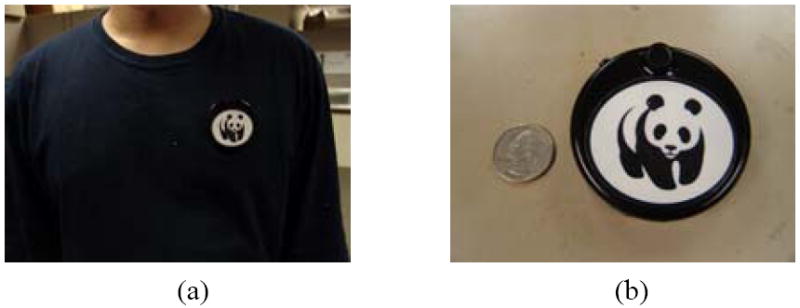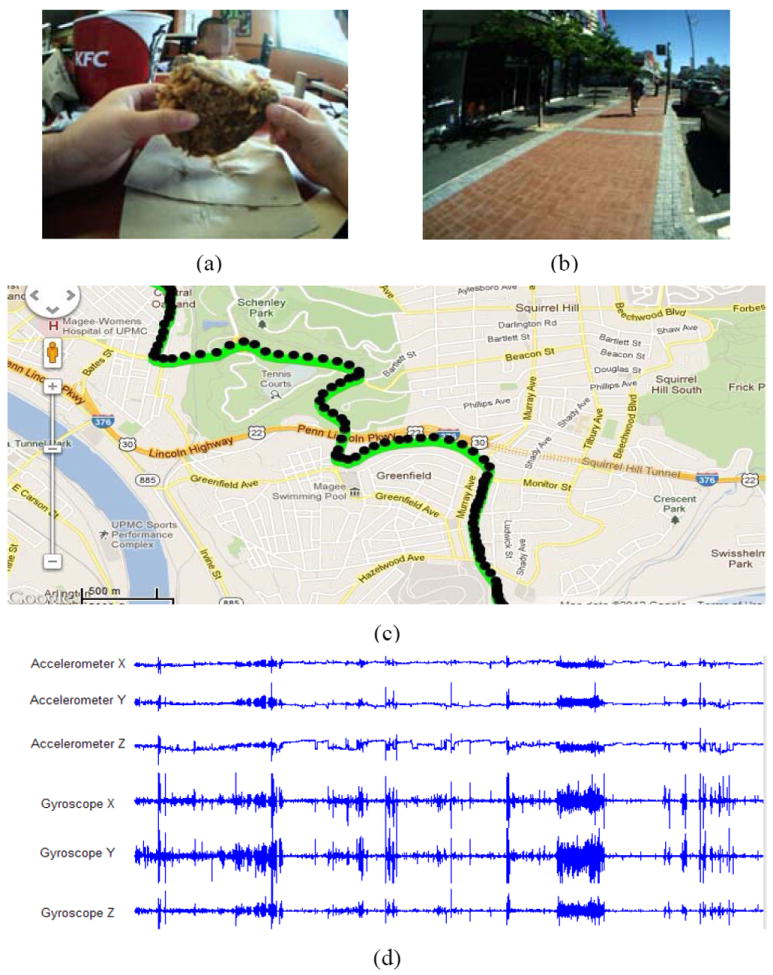Abstract
A wearable computer, called eButton, has been developed for evaluation of the human lifestyle. This ARM-based device acquires multimodal data from a camera module, a motion sensor, an orientation sensor, a light sensor and a GPS receiver. Its performance has been tested both in our laboratory and by human subjects in free-living conditions. Our results indicate that eButton can record real-world data reliably, providing a powerful tool for the evaluation of lifestyle for a broad range of applications.
I. Introduction
Lifestyle, including diet, physical activity, living environment, social interaction, etc., is a fundamental factor in personal health. In recent years, the rise of obesity and the increase in chronic diseases, such as cardiovascular disease, cancer, lung disease, and diabetes, have been closely related to unhealthy lifestyle [1]. Despite its importance, lifestyle cannot currently be evaluated objectively. Self-reporting has been the primary method of evaluation which depends on the memory and willingness of individuals to report their personal data and experience. This method is often unreliable and inaccurate [2]. There is a strong need to develop an objective tool to evaluate lifestyle. In this paper, we present our resent work on the design of a new wearable computer for lifestyle evaluation [3]. Our design utilizes advanced microelectronic sensors and devices as well as embedded programming for data acquisition and power management. Experimental results have shown initial success of our design.
II. Hardware and Measurement Mechanisms
Our wearable computer, eButton, can be worn naturally and conveniently like a chest button (Fig. 1), the diameter and thickness of this device are approximately 62mm and 11mm, respectively. Besides the CPU and storage components, eButton is equipped with a wide-angle digital camera module, a light sensor, a motion sensor (accelerometer), an orientation sensor (gyroscope), and a global positioning system (GPS) receiver. A lithium-ion rechargeable cell phone battery is utilized to supply power. eButton is designed to document almost every event in front of the wearer, and record his/her body movement, orientation and geographic location. The recorded data are stored and played back by researchers to evaluate lifestyle without depending on individuals’ self-reports.
Fig. 1.

(a) eButton is worn by a subject. (b) size of eButton comparing to a U.S. quarter.
Our wearable computer must collect data automatically from all sensors in an organized fashion. To meet this requirement, we selected the ARM based CPU from SAMSUNG, which is powerful, energy efficient, and widely used in handheld and mobile devices. To incorporate these sensors into eButton, we utilized multiple layers of printed circuit board (PCB), which included packages of sensors and complex connections.
eButton collects data from sensors simultaneously but store each form of data one by one within a collection cycle (epoch) with a user-selected time interval (usually one to several seconds). The epochs of data are then stored on a microSD card. The device supports up to 32GB in storage, which is enough for 320 hours of data. With a wide-angle camera, eButton can take pictures continuously at a user-specified rate to acquire lifestyle data. For example, a slower rate (several seconds per picture) is sufficient for eButton to record the process of eating. The acquired pictures are analyzed to identify the consumed food items and measure their volumes (portion sizes), nutrients, and calories based on image processing techniques and a USDA food database (FNDDS) [4]. In another example where eButton is used to evaluate physical activity, a faster picture taking rate (approximately one second per picture) is required. The image sequences recorded, along with the data from motion, orientation, light and GPS sensor, are segmented, categorized, and activities are identified. A physical activity compendium is utilized to obtain calorie expenditures [5,6].
III. Power Management
eButton is designed to collect the information about a person’s daily life, which frequently requires a long recording within a single battery cycle. Although the use of a large and heavy battery can solve this problem, the size and weight of the battery will make the device inconvenient and thus unwelcome by users. Alternatively, we conducted an extensive study on power management which consists of three levels: system level, CPU level and peripheral level.
A. System Level
Since we do not collect data constantly at every clock cycle, there is an interval between two epochs of data collection. During each epoch, power must be spent to ensure system performance. On the other hand, between two adjacent epochs, we have an opportunity to reduce power consumption by closing all possible power consuming parts which are inactive. We implemented this concept by the status of sleep. Specifically, we utilized the power management function of a driver provided by the operating system. This driver realized an entry sequence to enter a SLEEP state. After this state, a wake up strategy was applied. Our measurement indicated that the current during the sleep mode was reduced to 110mA from 420mA. Here we point out that the actual performance of this level of power management heavily depends on the percentage of the sleep time within the length of the complete epoch.
B. CPU Level
In computer circuit design, the system containing only CPU-related components is often referred to as the minimum system. We constructed a minimum system and measured its power consumption. Then, after all the sensors were installed on the system board, we measured the power consumption again. Our measurements indicated that all the sensors consumed about 35% of the total power. Thus, bringing down the consumption of CPU related circuit will enable us to save a significant amount of power.
At the CPU level, decreasing the operating frequency of CPU is the most widely used strategy in designing power management for an embedded system, as power consumption for CPU can be affected by the operating frequency tremendously. After modifying the values of several operating control registers of CPU and adding related code in the u-boot file, we decreased the operating frequency of the system from 532MHz-133MHz-66MHz to 266MHz-133MHz-66MHz. As a result, the working current dropped sharply by 50%.
C. Peripheral Level
At the peripheral level of power management, we monitored the working status for each device and used another feature in data collection, taking advantage of the interval between two cycles to control power consumption. According to the datasheets of sensors and the strategy of data collection, we disabled (rather than putting them to sleep) the sensors not operated by CPU during the interval to save power.
After all three levels of power control were applied to our system, the work time of eButton was increased by 60%.
IV. Test Results
eButton has been evaluated both in our laboratory and in free-living conditions. Approved by the institutional review board of the University of Pittsburgh, we have tested eButton on 18 human subjects with over 600 hours of data. Fig. 2 shows typical recorded sensor data. After the data are analyzed by our software, objective information about the wearer’s lifestyle can be obtained successfully.
Fig. 2.

Images captured by eButton: (a) eating; (b) walking; (c) route of travel on a Google map provided by the GPS sensor; (d) motion sensor data from the accelerometer (first three traces) and the gyroscope (last three traces).
V. Conclusion
We have developed a new wearable computer to objectively evaluate lifestyle. This portable device contains a powerful ARM CPU and a number of sensors to collect visual, motion, light intensity, and geographical data. We have adopted a compact architectural design and a three-level power management scheme to allow extended operation. Our evaluation of the wearable computer in real life has shown initial success of our design.
Acknowledgments
This work was supported in part by National Institutes of Health grant U01 HL91736.
References
- 1.Kopelman PG. Obesity as a medical problem. Nature. 2000;404(6778):635–643. doi: 10.1038/35007508. [DOI] [PubMed] [Google Scholar]
- 2.Stone A, Turkkan J, Bachrach C, Jobe J, Kertzman H, Cain V, editors. The science of self-report: implications for research and practice. Mahwah, NJ: Lawrence Erlbaum Associates; 2000. [Google Scholar]
- 3.Sun M, Fernstrom JD, Jia W, Hackworth SA, Yao N, Li Y, Li C, Fernstrom MH, Sclabassi RJ. A wearable electronic system for objective dietary assessment. J AM Diet Assoc. 2011;110(1):45–47. doi: 10.1016/j.jada.2009.10.013. [DOI] [PMC free article] [PubMed] [Google Scholar]
- 4.United States Department of Agriculture. Food and Nutrient Database for Dietary Studies. 2010 Available from: http://www.ars.usda.gov/services/docs.htm?docid=12089.
- 5.Metabolic Equivalent (MET) values for activities in American Time Use Survey (ATUS) National Cancer Institute. 2010 Available from: http://riskfactor.cancer.gov/tools/atus-met/
- 6.Ainsworth B, Haskell W, Herrmann S, Meckes N, Bassett JD, Tudor-Locke C, Greer J, Vezina J, Whitt-Glover M, Leon A. The Compendium of Physical Activities Tracking Guide. Healthy Lifestyles Research Center, College of Nursing & Health Innovation, Arizona State University; 2011. [Google Scholar]


